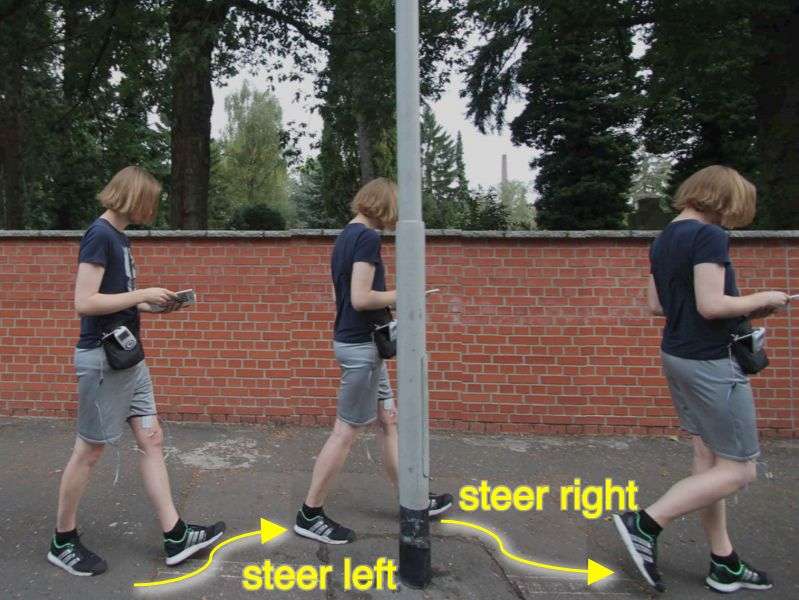April 14, 2015 weblog
Mapless walkers use electrical muscle stimulation (w/ video)

Say hello to "actuated navigation," a potentially new way of getting around in unfamiliar places. German scientists have been working on the first human satellite navigation –in the form of electrodes strapped to the legs to guide walkers. Applications could involve tourism, where visitors to unfamiliar places would no longer risk walking into poles and walls while struggling over paper maps and their smartphone apps to make their way around. Following directions would not be necessary.
In their paper, "Cruise Control for Pedestrians: Controlling Walking Direction Using Electrical Muscle Stimulation" authors Max Pfeiffer, Tim Dunte, Stefan Schneegass, Florian Alt, and Michael Rohs present their work. The team is from the universities of Hannover, Stuttgart and Munich.
They propose the concept of actuated navigation, whereby instead of delivering navigation information, "we provide an actuation signal that is processed directly by the human locomotion system and affects a change of direction. In this way, actuated navigation may free cognitive resources, such that users ideally do not need to attend to the navigation task at all."
Another potential application: directing firefighters in burning buildings. In sports, it could be used to steer runners via different jogging trails. or to guide the sports audience to their seats. It may help disoriented elderly people get back home.
How it works: This is a weak electrical signal, delivered to the muscles. In their work, the team used noninvasive surface electrodes placed on the skin. "The electrical signal elicits action potentials on motor nerves, which control muscle fibers. Stimulating the motor nerves leads to contraction of the muscle fibers. Using appropriate patterns, weak EMS can generate feedback similar to vibration," they wrote. They focused on the sartorius, a long and thin muscle that runs across the upper and anterior part of the thigh. It is connected to the pelvis and to the upper tibia. Contraction of the sartorius leads to flexion of the hip and the knee joints. Stimulating it electrically while walking leads to lateral rotation of the leg and therefore to a change of the walking direction. One electrode pair was attached to each leg of the participant and connected to the EMS device. The EMS signal was controlled through the mobile application.
How well does it work? For answers, they tested it out in the lab and out "in the wild." Sarah Knapton, science editor, The Telegraph, said students were successfully steered through a park in Hannover with the system. The researchers used a mobile phone to send Bluetooth signals to the electrodes. The student volunteers said the currents did not affect their stride.
The authors did find that, for a small percentage of their test users, "EMS [Electrical Muscle Stimulation] had very little or no effect on walking direction. Given the data that we have, we can only speculate whether this was due to sensor placement, higher skin resistance, physiological differences in muscle position, or unconscious counteracting against the small directional force generated by EMS."
They said for future work, they planned to include "a feedback loop for outdoor navigation (e.g., through GPS positioning) to automatically navigate the user towards a target destination. This will allow the system to be tested in a real-life setting."
More information: Study paper: Cruise Control for Pedestrians: Controlling Walking Direction using Electrical Muscle Stimulation (PDF) hci.uni-hannover.de/papers/pfe … fer2015CHICruise.pdf
© 2015 Tech Xplore





















